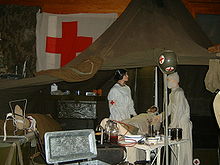
Protected persons is a legal term under international humanitarian law and refers to persons who are under specific protection of the 1949 Geneva Conventions, their 1977 Additional Protocols, and customary international humanitarian law during an armed conflict.
The legal definition of different categories of protected persons in armed conflicts is found in each 1949 Geneva Conventions and also in 1977 Additional Protocols.[6][7][8][9][10] The extent of protection and obligations of belligerent states and parties depends on the type of the armed conflict (international or not international) as well as on the category of protected persons in terms of their age (adult/child), sex (man/woman), participation in the armed conflict (combatant/prisoner of war/civil person) and personal situation (e.g. shipwrecked, sick, wounded, etc.).[11]
Minimum rights and fundamental guarantees are granted by the 1977 Additional Protocols I and II to the persons not covered by the 1949 Geneva Conventions, independently of the character of the conflict (international or national).[12] Moreover, the Additional Protocol II extended the protection of existing protected persons in non-international armed conflicts (persons deprived of liberty, wounded and sick, medical and religious personnel, civilian population).[13]
- ^ First Geneva Convention, Articles 38, 44.
- ^ Second Geneva Convention, Articles 41, 43.
- ^ Fourth Geneva Convention, Article 6.
- ^ Additional Protocol I, Article 38.
- ^ Additional Protocol II, Article 12.
- ^ Kolb, Robert (2003). Ius in Bello. Basel: Helbing & Lichtenhann. p. 155. ISBN 3-7190-2234-X.
- ^ First Geneva Convention, Article 13
- ^ Second Geneva Convention, Article 13
- ^ Third Geneva Convention, Article 4
- ^ Fourth Geneva Convention, Article 4
- ^ Kolb, Robert (2003). Ius in Bello. Basel: Helbing & Lichtenhann. p. 156. ISBN 3-7190-2234-X.
- ^ Additional Protocol I, Article 75.
- ^ "Additional Protocols to the Geneva Conventions of 1949" (PDF).